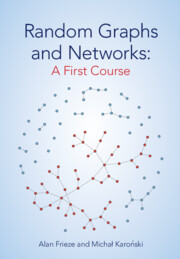Book contents
- Frontmatter
- Dedication
- Contents
- Preface
- Acknowledgments
- Conventions/Notations
- Part I Preliminaries
- Part II Erdős–Rényi–Gilbert Model
- 3 Uniform and Binomial Random Graphs
- 4 Evolution
- 5 Vertex Degrees
- 6 Connectivity
- 7 Small Subgraphs
- 8 Large Subgraphs
- 9 Extreme Characteristics
- Part III Modeling Complex Networks
- References
- Author Index
- Subject Index
4 - Evolution
from Part II - Erdős–Rényi–Gilbert Model
Published online by Cambridge University Press: 02 March 2023
- Frontmatter
- Dedication
- Contents
- Preface
- Acknowledgments
- Conventions/Notations
- Part I Preliminaries
- Part II Erdős–Rényi–Gilbert Model
- 3 Uniform and Binomial Random Graphs
- 4 Evolution
- 5 Vertex Degrees
- 6 Connectivity
- 7 Small Subgraphs
- 8 Large Subgraphs
- 9 Extreme Characteristics
- Part III Modeling Complex Networks
- References
- Author Index
- Subject Index
Summary
In this chapter, we mainly explore how the typical component structure evolves as the number of edges m increases. The following statements should be qualified with the caveat, w.h.p. The evolution of Erdős–Rényi–Gilbert type random graphs has clearly distinguishable phases. The first phase, at the beginning of the evolution, can be described as a period when a random graph is a collection of small components which are mostly trees. Next, a random graph passes through a phase transition phase when a giant component, of order comparable with the order of random graph, starts to emerge.
Information
- Type
- Chapter
- Information
- Random Graphs and Networks: A First Course , pp. 45 - 63Publisher: Cambridge University PressPrint publication year: 2023
